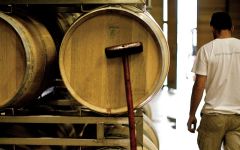Cesconi Moratel 2017



Product Details
Your Rating
Somm Note
Winemaker Notes






Perched high above Trento on banks of the Adige River is the hill of Pressano. In these rugged Alpine surroundings, the Cesconi family tends their vineyards planted to both red and white grapes. The current proprietors can trace their family roots back to the 17th century when their great-grandfather, then a citizen of the Austro-Hungarian Empire, would load his oxen with wine to sell to the summer court of the Habsburgs in Innsbruck. After the fall of the eastern dynasty, the Cesconi family would sell most of its productions to inns and taverns of Trento. Building on more than 2 centuries of cultivating and producing wine in Trentino, the four Cesconi brothers - Lorenzo, Roberto, Alexander and Franco - as well as their father Paul, continue the family tradition.
The family has a deep appreciation and respect for the achievements of their ancestors, however, they seek to build on this history by perfecting the traditional practices of the Domaine. To that end, Paul and Alexander work entirely organically in the vineyards and continue to move towards biodynamic methods. They believe that these practices are best for preserving the health and quality of their vineyards and for producing the best fruit. The vineyards of Cesconi are the gem of the Domaine; with more than two centuries as vignerons, their old vines, some over hundred years old, are more of a family heirloom than a financial asset.
Roberto and Lorenzo are quick to point out that there is no "recipe" for winemaking at Cesconi - one must provide room to interpret what nature has provided for each vintage and vineyard. Roberto and Lorenzo are interpreters, curators, of what the environment has provided for them. Fermentations are with native yeasts, and the white grapes usually undergo a short four to five day skin-fermentation in a process that is called, "Alzetta di Capello" or the rising of the cap. Grapes are placed in large oak or acacia fermenters with skins and stems with juice only taken off after the cap has begun to rise. No sulfur is used during vinification or elevage and large wood vessels of 3,000-5,000 liters are preferred for the aging of the white wines. Some smaller barrels are used for the reds, but the wood is neutral with new barrels only being purchased when absolutely necessary. Red macerations are kept relatively short to preserve aromatics and freshness and punchdown rather than pump over is generally preferred.

With hundreds of red grape varieties to choose from, winemakers have the freedom to create a virtually endless assortment of blended red wines. In many European regions, strict laws are in place determining the set of varieties that may be used, but in the New World, experimentation is permitted and encouraged resulting in a wide variety of red wine styles. Blending can be utilized to enhance balance or create complexity, lending different layers of flavors and aromas. For example, a red wine blend variety that creates a fruity and full-bodied wine would do well combined with one that is naturally high in acidity and tannins. Sometimes small amounts of a particular variety are added to boost color or aromatics. Blending can take place before or after fermentation, with the latter, more popular option giving more control to the winemaker over the final qualities of the wine.
How to Serve Red Wine
A common piece of advice is to serve red wine at “room temperature,” but this suggestion is imprecise. After all, room temperature in January is likely to be quite different than in August, even considering the possible effect of central heating and air conditioning systems. The proper temperature to aim for is 55° F to 60° F for lighter-bodied reds and 60° F to 65° F for fuller-bodied wines.
How Long Does Red Wine Last?
Once opened and re-corked, a bottle stored in a cool, dark environment (like your fridge) will stay fresh and nicely drinkable for a day or two. There are products available that can extend that period by a couple of days. As for unopened bottles, optimal storage means keeping them on their sides in a moderately humid environment at about 57° F. Red wines stored in this manner will stay good – and possibly improve – for anywhere from one year to multiple decades. Assessing how long to hold on to a bottle is a complicated science. If you are planning long-term storage of your reds, seek the advice of a wine professional.

Wine by Region › Italy › Trentino-Alto Adige › Alto Adige
Taking full advantage of direct sunlight exposure on its steep slopes, many of Alto Adige’s best vineyards are planted at extreme altitude... read more
